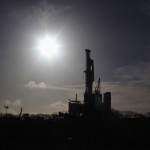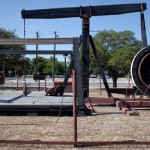Why West Texas Hopes This “Boom” is Different
In Midland, they try not to call it an oil boom because last time that happened in the 1980s, the economy went bust and stayed that way longer than anyone here wants to remember. But these days, things sure are boom-like.
K.C. Stallings, a landman, found that out when he moved last summer to Midland from Houston. He tried to buy a house.
“It’s the exact opposite as most of the country,” Stallings said.
Instead of homes sitting on the market for months, he could hardly find a three bedroom-two bath house on the market… at all.
“If it really was a good house, then it’d never make it on the market because there was enough word-of-mouth to go around, and there were enough desperate people to pay what the buyer wanted.”
After he and his family lived with a friend for three months, they heard about a house whose owner was ready to sell. They worked out a deal to buy the house before it was ever listed.
Midland’s 3.9% unemployment rate is the lowest in Texas. At the city’s BMW dealership, they can show you what’s behind the number. It’s actually behind the dealership: an oil well.
“We have one right in the back , in the back of the parking lot,” said Shane Denson, the sales manager.
In a field behind a line of new cars, a well pump jack bobs up and down. And just as it pumps out the oil, the dealership pumps out sales of luxury cars, 50% more than two years ago, said Denson.
“Everybody here is tied to the oil business. And even though we’re in the car business, we’re in the oil business,” said Denson.
Pump jacks and drilling rigs have been part of the landscape in Midland for decades. But now, they seem ubiquitous, especially northwest of the city where new, upscale homes have a view of oilfield equipment, sometimes as close as the lot next door.
“Things are as busy now as they’ve ever been,” said Ben Shepperd, president of the Permian Basin Petroleum Association which promotes the drilling industry in West Texas.
Some 400 rigs, a quarter of the nationwide total, are now drilling in the region. Shepperd said the industry is spending $1 billion a month here drilling wells. And the only way he said it makes economic sense is if oil prices don’t slide.
Shepperd is cautiously confident they won’t.
“This cycle we’re in right now seems to be a bit different,” said Shepperd. “I think the days of $20 oil are gone forever.”
The price per barrel, now at around $100, isn’t all drillers have to worry about. There’s something else, something that like the oil, is right under them: groundwater.
The Texas drought has hit hard here with some towns and ranches fearing they’ll run out of water completely. While some ranchers make money selling well water to the drilling operators, there’s concern that drilling operations are sucking so much water out of the aquifer that there won’t be enough for livestock and people.
Each well drilled using hydraulic fracturing, or fracking, can use several million gallons of water over days or weeks. The water is mixed with sand and chemicals, then sent deep underground at high pressure to fracture the shale rock formations, forcing out the oil trapped there.
New Texas regulations place no limits on how much water drillers can use, requiring only that drillers report the amount used (details on what’s in the fracking solution can be found at fracfocus.org)
Some counties estimate fracking may be using as much as 25% of their available groundwater and some local officials have called for drillers to completely stop using fresh water.
An alternative is to try to reduce the amount of water used by recycling it. Or, by purifying brackish groundwater that is too salty to drink or even use for fracking unless it’s treated.
“It’s becoming very commonplace,” said Brent Halldorson. He’s an engineer and runs Fort Worth-based Fountain Quail Water Management.
Fountain Quail has a tractor-trailer water purifying machine called “Rover”.
“The Rover is a very portable system that can go to the well site level and allow operators to reuse that water, over and over again.”
Halldorson said his company has been working in North Texas in the Barnett Shale. But in West Texas, drillers said the cost of purification needs to come down before it will be widely used.
The University of Texas Bureau of Economic Geology is doing a study to find out exactly how much groundwater drillers are using. The “Water for Texas 2012 State Water Plan” said initial results of the study found that while drilling constitutes just 1% of statewide water use, it “can be significantly larger in some localized areas” and “is expected to increase significantly through 2020” because of fracking. In what might be a warning to the industry, the the plan says “Future trends in these types of water use will be monitored closely in the upcoming planning process.”






